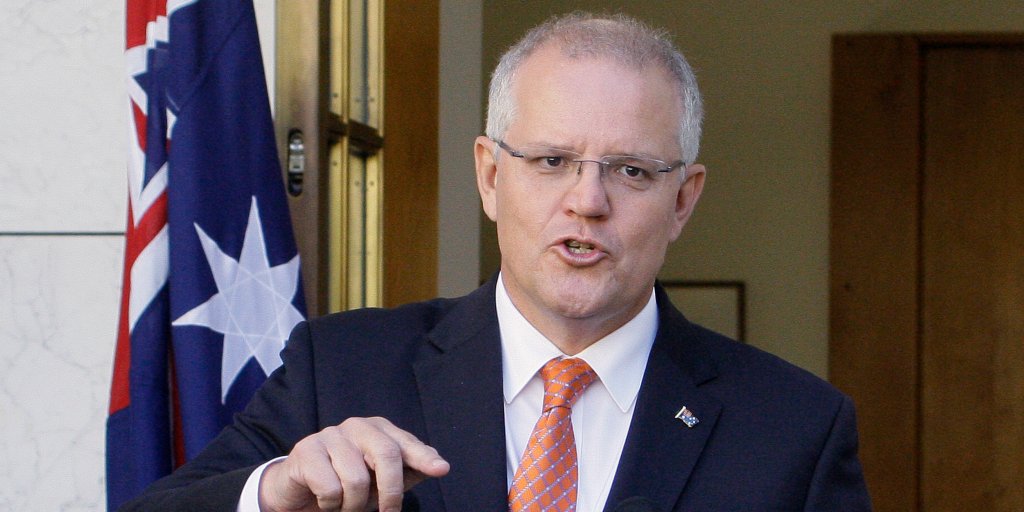ΣΧΟΛΙΟ ΙΣΤΟΛΟΓΙΟΥ : Όπως έχουμε επισημάνει ΕΔΩ και ΕΔΩ ...ο ανταγωνισμός μεταξύ Αυστραλίας και Κίνας θα φτάσει μέχρι την σύγκρουση. Όπως και η Ινδία, η Ιαπωνία...έτσι και η Αυστραλία θα μπεί στο ρίγκ με την Κίνα. Συμβουλή μου προς τους Αυστραλούς , όταν θα έρθει η ώρα η Κίνα θα έχει μόνο δύο υποθαλάσσιες διαδρομές προς τον Ινδικό Ωκεανό - τα Στενά του Lombok και τη Θάλασσα του Timor και για να το κάνει αυτό θα πρέπει να περάσει από τα Στενά του Malacca . Δεν μπορούν να χρησιμοποιήσουν τα Στενά της Μalacca ή τα Στενά της Sunda, εκτός εάν διέλθουν στην επιφάνεια.!! Και εκεί μπορεί κανείς να παίξει πολύ καλή..."μπαλίστα".
Scott Morrison has unveiled a more aggressive defence strategy aimed at countering the rise of China, while warning that Australia faces regional challenges on a scale not seen since World War II.
Scott Morrison has unveiled a more aggressive defence strategy aimed at countering the rise of China, while warning that Australia faces regional challenges on a scale not seen since World War II.
The strategy increases the focus on the Indo-Pacific
region, with the Prime Minister warning that Australia needs to prepare
for a post-COVID-19 world that is "poorer, more dangerous and more
disorderly".
Australia will build a larger military
that is focused on its immediate backyard, including new long-range
anti-ship missiles, signalling a major shift in the nation's defence
strategy.
"We have not seen the conflation of
global economic and strategic uncertainty now being experienced here in
Australia in our region since the existential threat we faced when the
global and regional order collapsed in the 1930s and 1940s," the Prime
Minister warned.
Mr Morrison also announced a
commitment to spend $270 billion over the next decade on defence
capabilities, including more potent strike weapons, cyber capabilities
and a high-tech underwater surveillance system.
Over
the next decade the Australian Defence Force (ADF) is expected to grow
by 800 people, comprising 650 extra personnel for the Navy, 100 for the
Air Force, and 50 for the Army.
According to
Defence's 2019-20 Budget Statement, the ADF was estimated to grow to
60,090 by this year, with 16,272 full-time public service staff.
Its
budget was expected to grow to 2 per cent of Australia's gross domestic
product by 2020-21, "equating to approximately $200 billion in
Australia's defence capability over 10 years", making the new
announcement an increase of $70 billion to the department.
In
a speech at the Australian Defence Force Academy Mr Morrison argued the
Indo-Pacific is the "epicentre" of rising strategic competition and
"the risk of miscalculation — and even conflict — is heightening".
Mr Morrison argued increasing Australia's defence capability was vital to shoring up the nation's position in the region.
"The
strategic competition between China and the United States means that
there's a lot of tension in the cord and a lot of risk of
miscalculation," Mr Morrison told Channel Seven.
"And
so we have to be prepared and ready to frame the world in which we live
as best as we can, and be prepared to respond and play our role to
protect Australia, defend Australia."
In releasing the 2020 Defence Strategy Update and the
accompanying Force Structure Plan, the Government confirmed Australia
would purchase the AGM-158C Long Range Anti-Ship Missile (LRASM) from
the United States Navy, at a cost of $800 million.
The
missile has a range of more than 370 kilometres and would be a
significant upgrade from the 124 km range of Australia's AGM-84
air-launched Harpoon anti-ship missile, introduced in the early 1980s.
Up
to $9.3 billion will also be spent on research and development into
high-speed, long-range weapons, including hypersonic weapons.
"The ADF now needs stronger deterrence capabilities," Mr Morrison told an audience of defence leaders.
"Capabilities
that can hold potential adversaries' forces and critical infrastructure
at risk from a distance, thereby deterring an attack on Australia and
helping to prevent war."
A massive underwater
surveillance system using high-tech sensors and costing between $5
billion and $7 billion is one of the biggest new purchases which could
eventually also include unmanned submarines.
Mr
Morrison has also promised to boost the ADF's ability to deal with what
he described as the "grey zone" — activity against Australia's interests
which falls below the threshold of traditional armed conflict.
'We're not talking about Canada'
Peter
Jennings from the Australian Strategic Policy Institute (ASPI) said the
world had changed dramatically since the last Defence White Paper was
released, particularly in the era of COVID-19.
"What
this policy document does is it starts to increase the hitting power of
the Defence Force in the short term, rather than being focused on
building submarines that will be ready in the late 2030s and into the
2040s," Mr Jennings told ABC RN.
Mr
Jennings said there was "only one country with both the capacity and
the desire to dominate the Indo-Pacific region in a way that works
against Australia's interest".
"We're not talking about Canada," he said.
"When
they talk about the bad behaviour that's happening in the region, the
annexation of territory, coercion, the influencing of domestic politics,
the use of cyber attacks – it's really only one country which is doing
that at industrial levels, and that's the People's Republic of China."
The Government will spend $15 billion on cyber and information warfare capabilities over the next 10 years, $1.3
billion of which will be used to boost the cyber security activities of
the Australian Signals Directorate and the Australian Cyber Security
Centre.
Including a network of satellites for
an independent communications network, $7 billion will also go towards
improving Defence's capabilities in space.
Mr
Morrison said the 10-year funding commitment went beyond the
Government's pledge to boost Defence spending to 2 per cent of GDP.


1 σχόλιο:
https://www.youtube.com/watch?v=kyF8skcOaCU
Δημοσίευση σχολίου